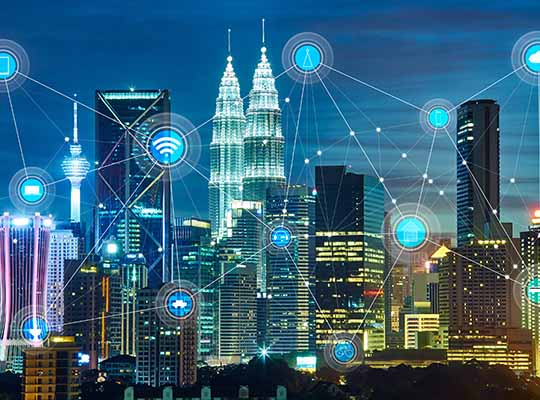The definition of a smart city would continue to evolve over the years. However, it is known that with the influence of communication and information technologies, the smart cities have enhanced services, sustainability, economic growth, and citizen well-being. With smart city technologies, cities can become more efficient and operative.
In recent years, there has been a growth in investments for smart technologies. Both the government and private sectors are eyeing on implementing the technology to create smart cities. The rise in federal subsidy and growing partnerships between city governments and private companies is fueling the adoption of smart technologies.
This technology has been extensively adopted to increase public safety from monitoring areas of high crime rates to enhancing emergency preparedness with sensors and many more. According to a report published by Allied Market Research, the global smart cities market is expected to garner $2.40 billion by 2025. The rise in initiatives taken by the government to generate smart cities, mounting urbanization, and a surge in need for a better quality of lifestyle are the major factor that would increase the investments for market growth.
Smart cities usher innumerable advantages-
Smart cities with connected technology offer innumerable benefits. The foremost advantage that it offers is an effective way of data-driven decision making. The advancements in connected devices and huge data have offered access to information to the cities. And, proper data analytics plans enable city officials to gather a huge amount of information and insights. This allows officials to have real-time monitoring and make decisions accordingly.
Secondly, expanding digital services in communities enhances smart cities. Citizens nowadays have greater expectations of their cities. Strong and user-friendly digital services such as collaboration tools, modern and spontaneous websites, mobile applications, self-service platforms, and suitable online accounts have become a living standard in many aspects.
A smart city is also a safer city. Using advanced technologies to track private/public partnerships and regarding data help to reduce criminal activities. Technologies including license plate identification, connected crime centers, and body cameras are all advancing law enforcement.
Smart cities also lead to a decrease in environmental footprints with energy-efficient constructions, renewable energy sources, and air quality sensors. These sensors would aid to detect the causes of air pollution in even the most populated cities, and therefore finding a cure for the same. Also, smart cities have aided with improved transportation. In recent years, investments for smart city transportation have been increased. Connected transportation systems offer great potential to expand productivity throughout a city. Smart city transportation has enhanced traffic management and public transportations along with offering the ability to track locations for bus or train locations. Moreover, smart technologies allow cities to better serve citizens despite rapid growth in population.
Not only to offer convenient services, but smart technologies have come out to be an advantage amid the global pandemic as well. To be more precise, Covid-19 has accelerated the adoption of smart technologies. Here are some of the examples of how smart technologies are aiding the cities, during the pandemic.
How smart city technologies are responding to Covid-19-
Covid-19 has immensely impacted on various industries. Social distancing has offered a new life under lockdown with virtual house parties, job interviews on video conferencing apps, live movie streaming, and many more. Not only in terms of mobile applications, but also technology adoption in the form of drones for offering contactless deliveries and police patrolling has become a norm.
In south-east Asia, in Singapore, smart nation resources have been used to curb the impacts of COVID 19. A robotic dog named spot has been used to help to promote safe distancing in the parks and gardens. Spot has in-built safety sensors to detect objects and people in its pathway and it is being controlled remotely. Moreover, the four-legged robot has been tested at the Changi Exhibition Centre community isolation facility to distribute vital items including medicines to patients.
Other than this, drones have been another aspect to prevent the impacts, during the pandemic. In several regions, drones have been used for surveillance purposes. The street surveillance authorities have also broadcasted the messages and information regarding lockdowns and social distancing. Also, e-commerce and food delivery services have used drones to deliver essential products in hospitals and homes to promote contactless deliveries.
It is yet unclear to predict the end of the pandemic. However, with these smart technologies and certain precautionary measures, it may become possible for the industries to survive through the pandemic. Moreover, with an increase in adoption, and government initiatives for smart cities, the global market is anticipated to grow exponentially.
Author’s Bio- Koyel Ghosh is a blogger with a strong passion and enjoys writing on miscellaneous domains, as she believes it lets her explore a wide variety of niches. She has an innate interest for creativity and enjoys experimenting with different writing styles. A writer who never stops imagining, she has been serving the corporate industry for the last three years.















